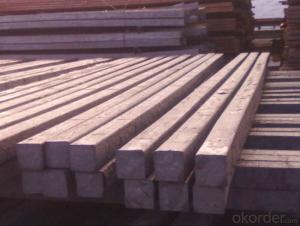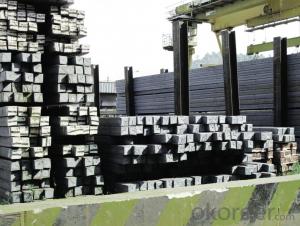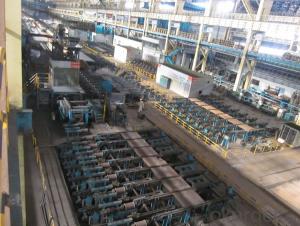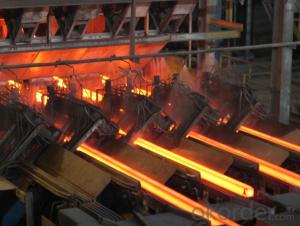Q235/3SP 95MM Blast Furnace Hot Rolled Steel Billet
- Loading Port:
- Tianjin
- Payment Terms:
- TT OR LC
- Min Order Qty:
- 2000 m.t.
- Supply Capability:
- 30000 m.t./month
OKorder Service Pledge
OKorder Financial Service
You Might Also Like
Description of Q235/3SP 95MM Blast Furnace Hot Rolled Steel Billet
Our hot dip galvanised steels consist of a steel substrate with a metallic zinc coating applied by means of a continuous hot dip galvanising process. Metallic zinc coatings are available in steel grades ranging from steel for bending and deep drawing applications, to structural steels and high yield strength steels.
A glossy surface finish obtained under specific skin-pass conditions (either non-skin-passed or skin- passed with smooth cylinders to obtain low roughness) can be provided if required at time of enquiry.
Advantage of Q235/3SP 95MM Blast Furnace Hot Rolled Steel Billet
Uncoated CR steel sheet With the features of in line with the international highest standards in demension and shape, excellent surface finish and properties, the products are mainly used in home appliance and automobile industries.
Galvanized steel sheet(include HDG and EG)
With the features of good corrosion resistance, the products are mainly used in automobile, home appliance, electronics, building and machinery manufacture industries, etc.
Precoated steel sheet With the features of enviromental protection and good processablility, long lasting surface durability, rich in colors, the products are maily used in building, home appliance and furniture industries, etc.
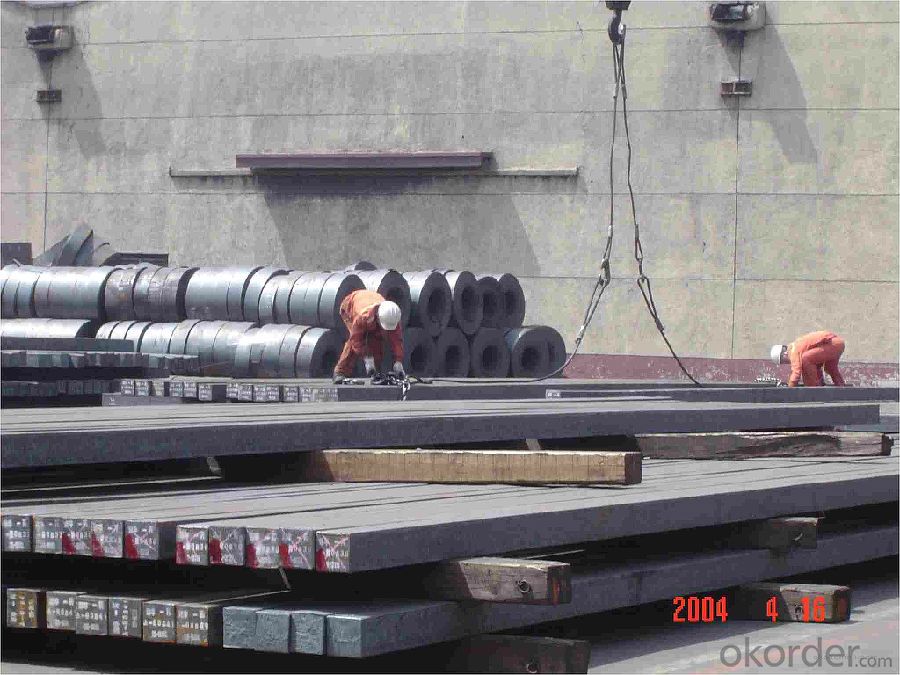
Applications of Q235/3SP 95MM Blast Furnace Hot Rolled Steel Billet
Our hot dip galvanised steels can be used in a very wide range of applications for industrial markets, both indoors and outdoors. Some of the most common applications are:
Building: wide sections for roofing and cladding, doors, door frames, metallic ceilings, partitions, structural members etc
Domestic appliances: all appliances for this sector (both white and brown goods) are manufactured with hot dip galvanised steels
Miscellaneous: electrical cabinets, aeraulic components, air conditioners, road signs etc
Zinc hot dip galvanised steel is suitable for contact with foodstuffs under certain conditions, as specified in European directive 89/109/EEC and French standard NF A 36-712-1. Please contact us for further information on this subject.
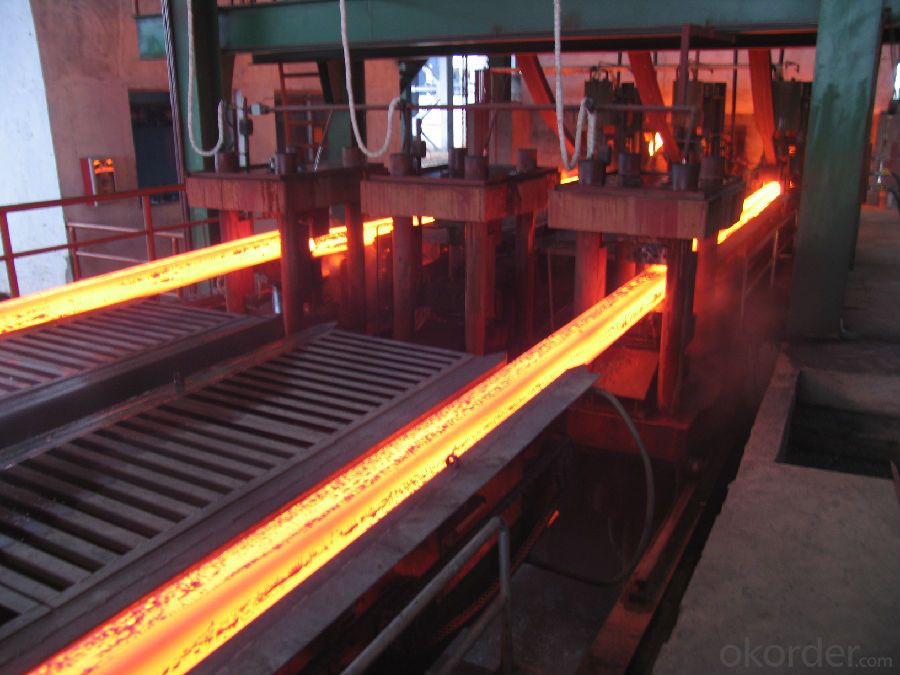
Specifications of Q235/3SP 95MM Blast Furnace Hot Rolled Steel Billet
Quality | Q/BQB 440-2003 | JIS G3312-1994 JIS G3321 | EN 10326-2004 | ASTM A653-02a |
EN 10327-2004 | (BASE PLATE) | |||
(BASE PLATE) | ||||
Commercial Steel | DC51D | SGCC SGLCC | DX51D+Z DX51D+AZ | CS Type A/B/C |
Forming Steel | St01,St02,St03 | SGCD1 SGLCD1 | FS Type A, Type B | |
Drawing | DC52D /DC53D | - | DX52D+Z DX52D+AZ | DDS TYPE A/C |
Steel | DX53D+Z DX53D+AZ | |||
Structural | S280GD (StE28) | SGC400 SGLC400 | S280D+Z DX54D+AZ | SS275 |
Steel | S350GD (StE34) | SGC440 SGLC440 | S350D+Z S350D+AZ | SS340 Class1 |
FAQ of Q235/3SP 95MM Blast Furnace Hot Rolled Steel Billet
We have organized several common questions for our clients,may help you sincerely:
1. How Can I Visit There?
Our company is located in Tianjin City, China, near Beijing. You can fly to Tianjin Airport Directly. All our clients, from home or aboard, are warmly welcome to visit us!
2. How Can I Get Some Sample?
We are honored to offer you sample.
3. Why choose CNBM?
Our delivery time about 15-20days for standard sizes, if you have other requirements like hardness, quanity and width ,it is about 20-40days. But don't worry we also try our best for the delivery time ,because time longer and our cost is higher.
- Q:How are steel billets marked for identification?
- Steel billets are typically marked for identification using a variety of methods such as stamping, engraving, or laser marking. This allows for important information like the grade, size, and batch number to be permanently etched onto the surface of the billet, ensuring easy identification and traceability throughout the manufacturing process.
- Q:How are steel billets used in the production of industrial valves?
- Steel billets are an essential component in the production of industrial valves. These billets serve as the raw material for manufacturing valve bodies, which are the main structural component of the valve. To begin the production process, steel billets are first heated to a specific temperature, usually through the use of a furnace. This heating process is crucial as it allows the billets to be malleable and easily shaped into the desired valve body design. Once the billets reach the required temperature, they are transferred to a special machine called a forging press. In the forging press, immense pressure is applied to the heated billet, causing it to take on the shape of a valve body. This process, known as forging, ensures that the valve body is strong, durable, and able to withstand the high pressures and temperatures of industrial applications. After the forging process, the valve bodies are then machined to achieve the final shape and dimensions. This involves using cutting tools to remove any excess material and refine the surface finish. The machined valve bodies are then inspected for quality assurance to ensure they meet the required specifications and standards. Once the valve bodies are ready, they undergo additional processes such as heat treatment and surface coating to enhance their strength, corrosion resistance, and overall performance. These treatments help to ensure that the valves can withstand harsh operating conditions and have a long service life. In summary, steel billets play a critical role in the production of industrial valves. They are heated and forged to create the valve bodies, which form the structural foundation of the valves. Through additional machining, heat treatment, and surface coating processes, the billets are transformed into high-quality valves that can effectively control the flow of fluids or gases in various industrial applications.
- Q:How are steel billets used in the manufacturing of aerospace components?
- Steel billets serve as a crucial raw material in the production of aerospace components. These semi-finished steel products, shaped like squares or rectangular solids, undergo a series of processes to become the required parts. To begin with, the steel billets go through a heating process called "hot working." This involves subjecting the billets to high temperatures, typically around 1200-1300°C, to increase their malleability and facilitate shaping. The heated billets are then passed through rolling mills, where they gradually decrease in size and take on the desired forms, such as bars, rods, or sheets. Once the steel billets have been shaped accordingly, they undergo further processing techniques like forging, extrusion, or machining to create specific aerospace components. For instance, the billets can be forged or machined to manufacture critical parts like engine shafts, landing gear components, or structural supports. The utilization of steel billets in aerospace manufacturing presents several advantages. Steel is renowned for its high strength, durability, and excellent mechanical properties, making it an ideal material for aerospace applications. Steel components can endure extreme conditions, such as high temperatures and pressures, while resisting corrosion and fatigue, thereby ensuring the safety and reliability of aerospace systems. Furthermore, steel billets can be customized to meet the stringent requirements of aerospace components. By carefully controlling the composition, heat treatment, and manufacturing processes, steel billets can be tailored to exhibit specific properties, such as a high strength-to-weight ratio, exceptional heat resistance, or enhanced fatigue life. This customization guarantees that the resulting aerospace components meet the industry's demanding standards. In conclusion, steel billets play a vital role in the production of aerospace components. Through a series of heating, shaping, and processing techniques, steel billets are transformed into various forms that are then further processed to create critical aerospace parts. The utilization of steel as a material offers exceptional strength, durability, and customization possibilities, thereby ensuring the production of high-quality and reliable aerospace components.
- Q:Can steel billets be customized in terms of shape and size?
- Steel billets have the capability to be personalized when it comes to their shape and size. These semi-finished products are typically rectangular in form and are utilized as raw materials for various manufacturing procedures. Nonetheless, they can be modified to fulfill specific requirements through a technique known as billet rolling or cross-rolling. Throughout this procedure, the steel billets are subjected to a series of rolls that are specially designed to exert pressure and force, resulting in their reshaping. This permits the customization of the billets into various shapes and sizes, such as square, round, or hexagonal, depending on the desired final product. Furthermore, the size of the steel billets can also be tailored. The initial dimensions of the billets can be altered by either increasing or decreasing their length, width, and height. This adaptability in customization empowers manufacturers to fabricate steel billets that best suit their specific production requirements. To sum up, steel billets can undoubtedly be customized in terms of both shape and size through the process of billet rolling. This empowers manufacturers to adjust the billets according to their desired specifications, enabling the creation of a wide array of products utilizing steel as a primary material.
- Q:How do steel billets contribute to energy efficiency?
- Steel billets contribute to energy efficiency in several ways. Firstly, the production of steel billets typically involves recycling scrap metal, which requires significantly less energy compared to producing steel from raw materials. This recycling process helps conserve energy and reduces the carbon footprint associated with steel production. Additionally, steel billets are often used as a raw material in various industries, such as construction and manufacturing. The durability and strength of steel make it a long-lasting and energy-efficient material for building structures and producing goods. Its high thermal conductivity also allows for efficient heat transfer, making it suitable for applications that require temperature control or energy conservation. Overall, steel billets play a vital role in promoting energy efficiency by minimizing energy consumption during production and offering sustainable solutions in various sectors.
- Q:What are the main challenges in the marketing of steel billets?
- There are several factors that contribute to the main challenges faced in marketing steel billets. To begin with, the highly competitive nature of the steel industry is a major hurdle. The market is saturated with numerous steel manufacturers and suppliers worldwide, making it difficult for companies to stand out and maintain a strong presence. In addition, fluctuations in global demand and supply of steel pose significant challenges. Steel billets are primarily used as raw material in industries like construction, automotive, and manufacturing. Any changes in these industries' demand directly affect the demand for steel billets. Therefore, marketing strategies must be adaptable and responsive to market dynamics in order to secure a stable customer base. Pricing is also a critical challenge. Steel billets are subject to price volatility due to factors such as raw material costs, energy prices, and global economic conditions. Companies must constantly analyze these factors to set competitive prices while ensuring profitability. Furthermore, a thorough understanding of the target market's needs and preferences is necessary for effective marketing. Different industries may require specific qualities and specifications in their billets, such as size, composition, or surface finish. To meet these requirements, companies must invest in research and development and effectively communicate the advantages of their products to potential customers. Establishing and maintaining strong relationships with customers is another challenge. Steel billets are typically sold through long-term contracts, relying on trust and reliability. Consistent quality, on-time delivery, and excellent customer service are essential for building and nurturing these relationships. Lastly, environmental sustainability has emerged as a challenge in the marketing of steel billets. With increasing environmental regulations and growing consumer awareness, companies need to position themselves as environmentally responsible and promote sustainable practices throughout their value chain. To conclude, marketing steel billets presents challenges related to intense competition, demand-supply dynamics, pricing, market understanding, customer relationships, and environmental sustainability. Overcoming these challenges requires strategic planning, continuous adaptation, and a customer-centric approach.
- Q:Charcoal is how to
- The trees cut into sections, lit in a kiln, burning to a certain extent, closed air into the kiln, waste heat to heat water and carbonization of wood, wood tar is leavened, carbonization of wood charcoal as. This is similar to charcoal used in home fires.
- Q:What are the main uses of steel billets in the automotive industry?
- Steel billets are widely used in the automotive industry for various applications. One of the main uses is the production of forged components such as crankshafts, connecting rods, and camshafts. These components require high strength and durability, and steel billets provide the necessary material properties to meet these requirements. Steel billets are also used in the manufacturing of gears, axles, and transmission shafts. These parts need to withstand heavy loads and provide smooth and efficient power transmission within the vehicle. Steel billets offer excellent mechanical properties, including high tensile strength and toughness, making them an ideal choice for such applications. Additionally, steel billets are used for producing suspension components like control arms, steering knuckles, and suspension links. These components play a critical role in maintaining the stability, control, and comfort of the vehicle. Steel billets are preferred for these parts due to their exceptional strength, stiffness, and impact resistance. Furthermore, steel billets find application in the production of body and chassis components. These include pillars, beams, frames, and reinforcements that provide structural integrity and crash protection to the vehicle. Steel billets offer superior strength-to-weight ratio, corrosion resistance, and formability, making them a popular choice for these safety-critical components. In summary, the main uses of steel billets in the automotive industry include forged components, gears and transmission parts, suspension components, and body and chassis components. Their exceptional mechanical properties make them indispensable for building durable, reliable, and safe vehicles.
- Q:What is the weight of a standard steel billet?
- The weight of a standard steel billet can vary depending on its dimensions, but typically ranges from 1 to 6 metric tons.
- Q:How do steel billets contribute to the overall recyclability of a structure?
- The overall recyclability of a structure is greatly enhanced by steel billets, which play a vital role. These semi-finished steel products are created by melting iron ore and other raw materials in a blast furnace. Steel billets possess various characteristics that contribute to a structure's recyclability, thanks to their composition and manufacturing process. Foremost, steel is one of the most recycled materials worldwide. Steel billets can be recycled endlessly without compromising their quality or integrity. Consequently, when a structure reaches the end of its lifespan, the steel components can be effortlessly dismantled, and the steel billets can be melted down to produce new steel products. This ability to recycle steel billets reduces the necessity for extracting and refining new iron ore, thereby conserving natural resources and minimizing the environmental impact associated with mining activities. Moreover, the recycling process of steel billets requires significantly less energy compared to producing steel from raw materials. Recycling steel billets consumes around 75% less energy than manufacturing steel from scratch. This energy efficiency not only reduces greenhouse gas emissions but also contributes to cost savings during the manufacturing process. By utilizing recycled steel billets in structure construction, we can mitigate the carbon footprint and promote sustainable practices within the construction industry. Additionally, the utilization of steel billets in structures provides practical advantages. Steel is renowned for its strength, durability, and resilience, making it an ideal material for constructing robust and long-lasting structures. By incorporating steel billets, structures can be designed to withstand various environmental conditions, such as earthquakes and hurricanes, guaranteeing the safety and longevity of the building. This aspect of longevity is crucial in terms of recyclability since it allows the structure to fulfill its purpose for an extended period before being recycled. In conclusion, steel billets significantly contribute to a structure's overall recyclability. Their ability to be recycled endlessly, reduced energy consumption during the recycling process, and practical advantages like strength and durability make steel billets an exceptional choice for constructing sustainable and recyclable structures. By incorporating steel billets, we can foster a circular economy, conserve natural resources, reduce emissions, and create a more sustainable future for the construction industry.
1. Manufacturer Overview |
|
|---|---|
| Location | |
| Year Established | |
| Annual Output Value | |
| Main Markets | |
| Company Certifications | |
2. Manufacturer Certificates |
|
|---|---|
| a) Certification Name | |
| Range | |
| Reference | |
| Validity Period | |
3. Manufacturer Capability |
|
|---|---|
| a)Trade Capacity | |
| Nearest Port | |
| Export Percentage | |
| No.of Employees in Trade Department | |
| Language Spoken: | |
| b)Factory Information | |
| Factory Size: | |
| No. of Production Lines | |
| Contract Manufacturing | |
| Product Price Range | |
Send your message to us
Q235/3SP 95MM Blast Furnace Hot Rolled Steel Billet
- Loading Port:
- Tianjin
- Payment Terms:
- TT OR LC
- Min Order Qty:
- 2000 m.t.
- Supply Capability:
- 30000 m.t./month
OKorder Service Pledge
OKorder Financial Service
Similar products
New products
Hot products
Related keywords
